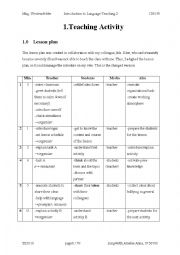
|
Cyberb ullying Lesson Plan and Materials
This is a full lesson plan that includes all the materials needed to teach a lesson on cyber bullying. It includes reading, finding new words in the text/guessing their meaning from the context, a group discussion and taking notes.
Here is the full, step-by-step description of the lesson:
After having set the lesson schedule, I explain the first task, which is on handout A and then hand it out. Letting the students first think about the topic, their experiences with mobbing and the vocabulary that they think they will need to talk about it, activates their schematic knowledge (Hedge 2000: 210, 232) and will help them, to understand the video and do the reading task. Letting them share their findings with the class gives them the opportunity to add ideas and words to their own notes.
The next step is to explain the activity B, which will involve the students to watch a short video-clip about cyber-mobbing, so they can work out the difference between casual mobbing and cyber-bullying. I let them watch it twice, so they can get used to the language that is used and understand the content schemata (Hedge 2000: 233) that is referred to within the video. After watching the video, I have to prompt the students to describe the differences and help them with vocabulary they need.
The following activities that are described in steps 9 to 13, are the core of this lesson and deal with reading and comprehending the text on handout C. The while-reading activity involves the students in answering questions, which reflect the main ideas of the text. To connect two skills, I decided that the students have to check their answers in groups, so they can benefit from peer-correction (Hedge 2000: 164) using achievement strategies (Hedge 2000: 265) to ensure the communication of meaning.
For the last activity on handout D, the students have to reread some parts of the text in order to work out the meaning for at least three words they do not know from the context and compare their theories with colleagues. I aimed at broadening their vocabulary by asking them to do the task. One danger of this activity could be that the students do not use the contextual clues or a dictionary and ask me instead. To increase the value of this activity I could ask one group to start scanning from the end of the text, backwards, so to say. This would enlarge the number of new words, once we have compared everyone’s findings.
In case some of the students are faster than others, I have prepared an additional task on handout E, which involves the students in a discussion.
Level:intermediate
Age: +14
Downloads:44 |
|
Copyright 09/12/2015 Amelie Jungwirth
Publication or redistribution of any part of this
document is forbidden without authorization of the
copyright owner.
|


see more worksheets by princess.amelica
|